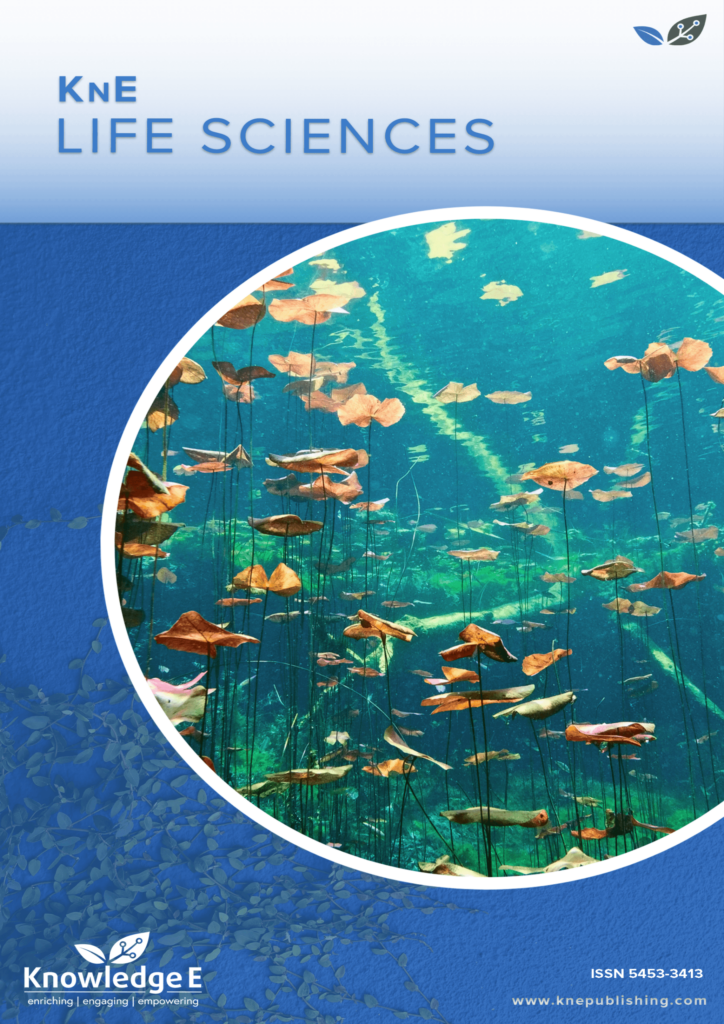
KnE Life Sciences
ISSN: 2413-0877
The latest conference proceedings on life sciences, medicine and pharmacology.
Isolation of Flower Development Regulator Gene SEPALLATA 1 in Phalaenopsis amabilis (L.) Blume
Published date:Jul 11 2017
Journal Title: KnE Life Sciences
Issue title: The 4th International Conference on Biological Science (2015)
Pages:54-60
Authors:
Abstract:
Phalaenopsis amabilis (L.) Blume is an indigenous orchid species in Indonesia. This orchid has a white large flower. The large flower is caused by the existence of gene that has an important role in flower development. One of the genes is SEPALLATA 1. This gene is a member of superfamily MADS-Box gene. SEPALLATA 1 gene is a marker of primordial flower organ. This study aimed to isolate SEPALLATA1 gene from Phalaenopsis amabilis (L.) Blume by PCR using forward primer 5’-GCT-GGA-GCG-GAT-CGA-GAA-CA-3’and reverse primer 5’-TCA-TGC-AAG-CCA-ACC-AGG-TG-3’. This study successfully amplified 691 bp lengths of SEPPALATA1 fragment, lacking 20 bp upstream which consist its start codon.
Keywords: Flower development regulation, Phalaenopsis amabilis (L.) Blume, SEPALLATA 1 gene.
References:
[1] H. Yu and C. J. Goh, “Identification and characterization of three orchid MADS-box genes of the AP1/AGL9 subfamily during floral transition,” Plant Physiology, vol. 123, no. 4, pp. 1325–1336, 2000.
[2] R. Peakall, “Speciation in the Orchidaceae: Confronting the challenges,” Molecular Ecology, vol. 16, no. 14, pp. 2834–2837, 2007.
[3] T. Gunadi, Anggrek dari bibit hingga berbunga. [Orchid from seed to flowering], PAI Bandung, Bandung, 1979, in Bahasa Indonesia.
[4] HL. Valmayor, Orchidiana Philippiniana, vol. 1, 1983, Los Banos: University of the Philippines.
[5] CA. Backer and VDB. Bachuizen, Flora of Java (Vol III, The, Netherland: Noodhoof. N.V.P, 1968.
[6] EB. Hidajat, “Morfologi tumbuhan. [Plant morphology]., Bandung,” Departemen Pendidikan dan Kebudayaan, 1994.
[7] D. F. Ip, “Book Reviews : THE SOCIOLOGY OF MODERNIZATION AND DEVELOPMENT. David Harrison. London, Unwin Hyman Academic, 1988. 196 pp. $29.95 (paper),” Journal of Sociology, vol. 26, no. 2, pp. 244–246, 1990.
[8] R. Cui, J. Han, S. Zhao et al., “Functional conservation and diversification of class e floral homeotic genes in rice (Oryza sativa),” Plant Journal, vol. 61, no. 5, pp. 767–781, 2010.
[9] Z.-J. Pan, Y.-Y. Chen, J.-S. Du et al., “Flower development of Phalaenopsis orchid involves functionally divergent SEPALLATA-like genes,” New Phytologist, vol. 202, no. 3, pp. 1024–1042, 2014.
[10] H. Ma, M. F. Yanofsky, and E. M. Meyerowitz, “AGL1-AGL6, an Arabidopsis gene family with similarity to floral homeotic and transcription factor genes,” Genes and Development, vol. 5, no. 3, pp. 484–495, 1991.
[11] H. Huang, M. Tudor, C. A. Weiss, Y. Hu, and H. Ma, “The Arabidopsis MADS-box gene AGL3 is widely expressed and encodes a sequence-specific DNA-binding protein,” Plant Molecular Biology, vol. 28, no. 3, pp. 549–567, 1995.
[12] M. A. Mandel and M. F. Yanofsky, “The Arabidopsis AGL9 MADS box gene is expressed in young flower primordia,” Sexual Plant Reproduction, vol. 11, no. 1, pp. 22–28, 1998.
[13] L. M. Zahn, H. Kong, J. H. Leebens-Mack et al., “The evolution of the SEPALLATA subfamily of MADS-box genes: A preangiosperm origin with multiple duplications throughout angiosperm history,” Genetics, vol. 169, no. 4, pp. 2209–2223, 2005.
[14] L. J. Cseke, S. B. Cseke, N. Ravinder et al., “SEP-class genes in Populus tremuloides and their likely role in reproductive survival of poplar trees,” Gene, vol. 358, no. 1-2, pp. 1–16, 2005.
[15] S. Pelaz, G. S. Ditta, E. Baumann, E. Wisman, and M. F. Yanofsky, “B and C floral organ identity functions require SEPALLATTA MADS-box genes,” Nature, vol. 405, no. 6783, pp. 200–203, 2000.
[16] O. A. Shulga, A. V. Shchennikova, G. C. Angenent, and K. G. Skryabin, “MADS-box genes controlling inflorescence morphogenesis in sunflower,” Russian Journal of Developmental Biology, vol. 39, no. 1, pp. 2–5, 2008.
[17] G. Theißen, “Development of floral organ identity: Stories from the MADS house,” Current Opinion in Plant Biology, vol. 4, no. 1, pp. 75–85, 2001.
[18] Y. Xu, L. L. Teo, J. Zhou, P. P. Kumar, and H. Yu, “Floral organ identity genes in the orchid Dendrobium crumenatum,” Plant Journal, vol. 46, no. 1, pp. 54–68, 2006.
[19] Z.-X. Lu, M. Wu, C.-S. Loh, C.-Y. Yeong, and C.-J. Goh, “Nucleotide sequence of a flower-specific MADS box cDNA clone from orchid,” Plant Molecular Biology, vol. 23, no. 4, pp. 901–904, 1993.